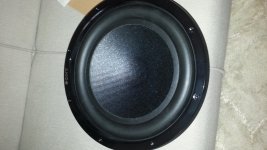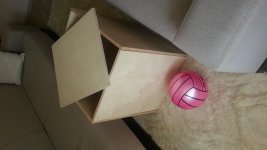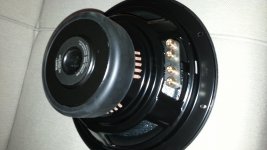^ That's way dados aren't the best way to go with MDF. An offset T&G affair can't get out of plane. The shoulder of the tongue holds the panel straight. Since the MDF swells you use that to your advantage in the joint. Using an offset T&G the swelling will actually help pull the MDF down into the groove. Tongue should be shy of the bottom by about 1/32" and fit the groove width just snugly ... not too tight or loose. The shoulders dictates the interior dimension. Do it right and clamping is minimal.
Like your choice of table saw too. ... best ever made IMO. Your grand kids will be using it. Just a tip though ... check that the blade line is parallel with the table. Use a mic in the miter gauge groove to a fully elevated blade, front tooth and back tooth measurements. There are four bolts under the table corners to allow adjustment.
Like your choice of table saw too. ... best ever made IMO. Your grand kids will be using it. Just a tip though ... check that the blade line is parallel with the table. Use a mic in the miter gauge groove to a fully elevated blade, front tooth and back tooth measurements. There are four bolts under the table corners to allow adjustment.
Sony XS gsw21d subwoofer sealed box bracing
Hi.I am building a subwoofer hor my home.Dimensions 56x53x52cm
Internal volume about 100lt
Birch plywood
But i forgot to cut internal brace from Bauhaus carpenter
I will cut another piece of 52x53cm of plywood or MDF
I read bracing holes shapes are important for air flow.(My box will be sealed though)
Should i cut 4 square or circle or elyptical pieces from big sheet? Thanks
Hi.I am building a subwoofer hor my home.Dimensions 56x53x52cm
Internal volume about 100lt
Birch plywood
But i forgot to cut internal brace from Bauhaus carpenter
I will cut another piece of 52x53cm of plywood or MDF
I read bracing holes shapes are important for air flow.(My box will be sealed though)
Should i cut 4 square or circle or elyptical pieces from big sheet? Thanks
Last edited:
I am using 1" MDF all round and a 2" MDF baffle and 1" MDF bracing with cutouts. ...I am getting very little cracks in the MDF
Late to the show, but...
You gotta love MDF. you'd be way ahead with 18mm quality ply, particularily for a woofer.
dave
Might as well add my late 2-cents too.
Thread has a lot of wise woodworking guidance but seems to be short on mechanical engineering posts. So here are my intuitions.
The enemy is large expanses of unbraced wall. Even quite thick materials will "drum head" if the expanse is large enough in a sub.
Adding smart structural bracing is far superior to increasing wall thickness. What you want is bracing across the box to an opposite side. The simple cross-forces involved in that kind of tensile strength hardly justify fussing with dado and fancy routing, so long as you aren't splitting the "end grain" or obvious defective work like that. Needless to say, compressive forces in bracing to opposite sides is a non-issue.
Even just an old broom handle, dowel rod, or length of electrical conduit pipe stuck across the middle and held in place with a lump of epoxy works nicely if the work is done properly.
Don't forget to make the front panel strong too. Has that big hole for driver, eh.
Taking a quarter-inch from the wall thickness will lower the box resonance for the same outside envelope.
Finally, we all believe great stiffness is important. But I'd be glad to read a link to any research on just how stiff it needs to be.... anyway, I actually think leaky sealed boxes are a good idea or maybe well stuffed open-back boxes. Try that in your sim program.
Ben
Thread has a lot of wise woodworking guidance but seems to be short on mechanical engineering posts. So here are my intuitions.
The enemy is large expanses of unbraced wall. Even quite thick materials will "drum head" if the expanse is large enough in a sub.
Adding smart structural bracing is far superior to increasing wall thickness. What you want is bracing across the box to an opposite side. The simple cross-forces involved in that kind of tensile strength hardly justify fussing with dado and fancy routing, so long as you aren't splitting the "end grain" or obvious defective work like that. Needless to say, compressive forces in bracing to opposite sides is a non-issue.
Even just an old broom handle, dowel rod, or length of electrical conduit pipe stuck across the middle and held in place with a lump of epoxy works nicely if the work is done properly.
Don't forget to make the front panel strong too. Has that big hole for driver, eh.
Taking a quarter-inch from the wall thickness will lower the box resonance for the same outside envelope.
Finally, we all believe great stiffness is important. But I'd be glad to read a link to any research on just how stiff it needs to be.... anyway, I actually think leaky sealed boxes are a good idea or maybe well stuffed open-back boxes. Try that in your sim program.
Ben
Last edited:
The OP, if I am not mistaken asked for how much of the brace, if a shelf brace is used?, needs to be taken away. Didn't see an answer to that one.
It needs to have at least 50% removed, preferably more, but within reason so that you don't make the wood so thin as to be ineffective as bracing.
It needs to have at least 50% removed
We typically remove 30-40% in ours.
dave
- Status
- Not open for further replies.
- Home
- Loudspeakers
- Subwoofers
- Cracks in Sub box bracing.



